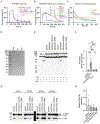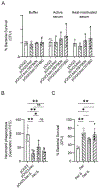Group B Streptococcus Surface Protein β: Structural Characterization of a Complement Factor H-Binding Motif and Its Contribution to Immune Evasion
- PMID: 35110419
- PMCID: PMC8881398
- DOI: 10.4049/jimmunol.2101078
Group B Streptococcus Surface Protein β: Structural Characterization of a Complement Factor H-Binding Motif and Its Contribution to Immune Evasion
Abstract
The β protein from group B Streptococcus (GBS) is a ∼132-kDa, cell-surface exposed molecule that binds to multiple host-derived ligands, including complement factor H (FH). Many details regarding this interaction and its significance to immune evasion by GBS remain unclear. In this study, we identified a three-helix bundle domain within the C-terminal half of the B75KN region of β as the major FH-binding determinant and determined its crystal structure at 2.5 Å resolution. Analysis of this structure suggested a role in FH binding for a loop region connecting helices α1 and α2, which we confirmed by mutagenesis and direct binding studies. Using a combination of protein cross-linking and mass spectrometry, we observed that B75KN bound to complement control protein (CCP)3 and CCP4 domains of FH. Although this binding site lies within a complement regulatory region of FH, we determined that FH bound by β retained its decay acceleration and cofactor activities. Heterologous expression of β by Lactococcus lactis resulted in recruitment of FH to the bacterial surface and a significant reduction of C3b deposition following exposure to human serum. Surprisingly, we found that FH binding by β was not required for bacterial resistance to phagocytosis by neutrophils or killing of bacteria by whole human blood. However, loss of the B75KN region significantly diminished bacterial survival in both assays. Although our results show that FH recruited to the bacterial surface through a high-affinity interaction maintains key complement-regulatory functions, they raise questions about the importance of FH binding to immune evasion by GBS as a whole.
Copyright © 2022 by The American Association of Immunologists, Inc.
Figures






Similar articles
-
Staphylococcus aureus surface protein SdrE binds complement regulator factor H as an immune evasion tactic.PLoS One. 2012;7(5):e38407. doi: 10.1371/journal.pone.0038407. Epub 2012 May 31. PLoS One. 2012. PMID: 22675461 Free PMC article.
-
Acquisition of factor H by a novel surface protein on group B Streptococcus promotes complement degradation.FASEB J. 2009 Nov;23(11):3967-77. doi: 10.1096/fj.09-138149. Epub 2009 Jul 16. FASEB J. 2009. PMID: 19608625 Free PMC article.
-
The group B streptococcal beta and pneumococcal Hic proteins are structurally related immune evasion molecules that bind the complement inhibitor factor H in an analogous fashion.J Immunol. 2004 Mar 1;172(5):3111-8. doi: 10.4049/jimmunol.172.5.3111. J Immunol. 2004. PMID: 14978117
-
Hijacking Factor H for Complement Immune Evasion.Front Immunol. 2021 Feb 25;12:602277. doi: 10.3389/fimmu.2021.602277. eCollection 2021. Front Immunol. 2021. PMID: 33717083 Free PMC article. Review.
-
Complement factor H-ligand interactions: self-association, multivalency and dissociation constants.Immunobiology. 2012 Feb;217(2):281-97. doi: 10.1016/j.imbio.2011.10.003. Epub 2011 Oct 28. Immunobiology. 2012. PMID: 22137027 Review.
Cited by
-
The Inhibitory Effects of a Factor B-Binding DNA Aptamer Family Supersede the Gain of Function of Factor B Variants Associated with Atypical Hemolytic Uremic Syndrome.J Immunol. 2024 Dec 1;213(11):1691-1702. doi: 10.4049/jimmunol.2400420. J Immunol. 2024. PMID: 39431879
-
Current research update on group B streptococcal infection related to obstetrics and gynecology.Front Pharmacol. 2024 Jun 17;15:1395673. doi: 10.3389/fphar.2024.1395673. eCollection 2024. Front Pharmacol. 2024. PMID: 38953105 Free PMC article. Review.
-
An opportunistic pathogen under stress: how Group B Streptococcus responds to cytotoxic reactive species and conditions of metal ion imbalance to survive.FEMS Microbiol Rev. 2024 May 8;48(3):fuae009. doi: 10.1093/femsre/fuae009. FEMS Microbiol Rev. 2024. PMID: 38678005 Free PMC article. Review.
References
-
- Doran KS, and Nizet V. 2004. Molecular Pathogenesis of Neonatal Group B Streptococcal Infection: No Longer in its Infancy. Mol. Micro 54: 23–31. - PubMed
-
- Ruppen C, Notter J, Strahm C, Sonderegger B, and Sendi P. 2018. Osteoarticular and skin and soft-tissue infections caused by Streptococcus agalactiae in elderly patients are frequently associated with bacteremia. Diagnostic microbiology and infectious disease 90: 55–57. - PubMed
-
- Leclercq SY, Sullivan MJ, Ipe DS, Smith JP, Cripps AW, and Ulett GC. 2016. Pathogenesis of Streptococcus urinary tract infection depends on bacterial strain and β-hemolysin/cytolysin that mediates cytotoxicity, cytokine synthesis, inflammation and virulence. Scientific reports 6: 1–14. - PMC - PubMed
-
- Saad EJ, Baenas DF, Boisseau CS, García MJ, Núñez SA, Sanchez PE, Balderramo DC, Hernández D, and Caeiro JP. 2018. Streptococcus agalactiae bacteremia in non-pregnant adult patients at two teaching hospitals. Revista Argentina de microbiologia 50: 280–284. - PubMed
Publication types
MeSH terms
Substances
Grants and funding
LinkOut - more resources
Full Text Sources
Miscellaneous

